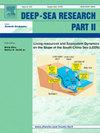东北印度洋中新世至更新世高分辨率钙质纳米化石生物地层学:生物层位、全球对比、古地理、古生态学和沉积速率综合分析
IF 3
3区 地球科学
Q2 OCEANOGRAPHY
Deep-sea Research Part Ii-topical Studies in Oceanography
Pub Date : 2025-07-22
DOI:10.1016/j.dsr2.2025.105517
引用次数: 0
摘要
对东北印度洋近海中新世至更新世沉积物中钙质纳米化石含量进行了深入分析。安达曼-尼科巴盆地NGHP岩心(NGHP-01- 17a)沉积物具有显著的钙质纳米化石生物地层标志/指数分类群。石灰质纳米化石生物层/带可归属于Martini(1971)的NN9 ~ NN19带,对应于Backman et al.(2012)的CNM13 ~ CNPL7带。重要的钙质纳米化石生物事件表明,研究样品的时代从晚中新世即托尔顿世(9.81 Ma)到早更新世即格莱世(1.81 Ma)。本文记录的钙质纳米化石组合与位于中低纬度的其他深海钻探点(DSDP, ODP和IODP)所描述的组合非常相似。在古生态学背景下,重要和优势的钙质纳米化石包括Discoaster、Helicosphaera、Reticulofenestra(小<; 3 μm)、Reticulofenestra(大>; 3 μm)和Sphenolithus,次优势种为Calcidiscus leptoporus和Coccolithus pelagicus。利用重要的钙质纳米化石生物层位,重建了晚中新世(托尔顿期)至早更新世(格雷斯期)的沉积速率。估计托尔顿期和墨西尼亚期的平均沉积速率分别为~ 208 m/Ma和~ 64 m/Ma。但上新世沉积速率明显下降。上新世和更新世(Gelasian)沉积速率分别为~ 34 m/Ma和~ 14 m/Ma。本文章由计算机程序翻译,如有差异,请以英文原文为准。
High resolution Miocene to Pleistocene calcareous nannofossil biostratigraphy from northeast Indian Ocean: A comprehensive analysis on biohorizons, global correlation, palaeogeography, palaeoecology and sedimentation rate
An in-depth analysis on the calcareous nannofossil content in the Miocene to Pleistocene sediments from the offshore of northeast Indian Ocean has been carried out. The sediments of the NGHP core (NGHP-01-17A) drilled at Andaman-Nicobar Basin are characterized by significant biostratigraphically marker/index taxa of calcareous nannofossils. The calcareous nannofossil biohorizons/zones are assignable to NN9─NN19 zones of Martini (1971) that correspond to CNM13─CNPL7 zones of Backman et al. (2012). The significant calcareous nannofossil bio-events indicate an age from late Miocene i.e., Tortonian (9.81 Ma) to early Pleistocene i.e., Gelasian (1.81 Ma) for the studied samples. The calcareous nannofossil assemblages recorded herein are closely comparable to the assemblages described from other deep sea drilling sites (DSDP, ODP and IODP) located at lower mid latitudes. In the context of palaeoecology, the important and dominant calcareous nannofossils include species of Discoaster, Helicosphaera, Reticulofenestra (small < 3 μm), Reticulofenestra (large > 3 μm) and Sphenolithus, whereas, the subdominant species are Calcidiscus leptoporus and Coccolithus pelagicus. Using the significant calcareous nannofossil biohorizons the sedimentation rate from late Miocene (Tortonian) to early Pleistocene (Gelasian) has been reconstructed. The estimated average sedimentation rates during Tortonian and Messinian are ∼208 m/Ma and ∼64 m/Ma respectively. However, the sedimentation rate during the Pliocene substantially declined. During the Pliocene and Pleistocene (Gelasian) the sedimentation rates have been estimated ∼34 m/Ma and ∼14 m/Ma respectively.
求助全文
通过发布文献求助,成功后即可免费获取论文全文。
去求助
来源期刊
CiteScore
6.40
自引率
16.70%
发文量
115
审稿时长
3 months
期刊介绍:
Deep-Sea Research Part II: Topical Studies in Oceanography publishes topical issues from the many international and interdisciplinary projects which are undertaken in oceanography. Besides these special issues from projects, the journal publishes collections of papers presented at conferences. The special issues regularly have electronic annexes of non-text material (numerical data, images, images, video, etc.) which are published with the special issues in ScienceDirect. Deep-Sea Research Part II was split off as a separate journal devoted to topical issues in 1993. Its companion journal Deep-Sea Research Part I: Oceanographic Research Papers, publishes the regular research papers in this area.

 求助内容:
求助内容: 应助结果提醒方式:
应助结果提醒方式:


